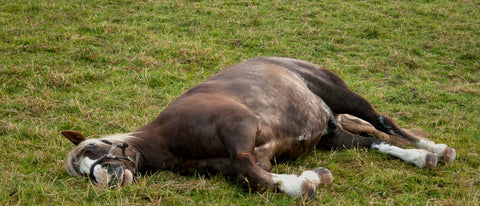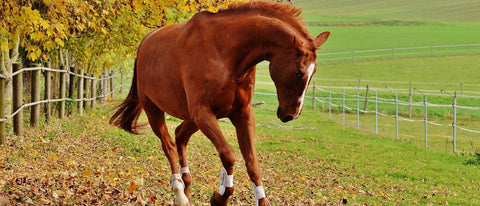
Florian ist aufgewachsen auf einem Bauernhof. Umgeben von Pferden, entdeckte er früh seine Faszination für diese majestätischen Tiere. Inspiriert von seiner reitbegeisterten Mutter, entwickelte er das Nahrungsergänzungmittel - Pferdegold. Seine tiefe Verbundenheit zur Natur und die leidenschaftliche Hingabe zu Pferden trieben ihn an, sein Unternehmen zu gründen.
Strangles in horses isn't just a cold, but a serious and highly contagious disease . If you have several horses, the entire herd can quickly become infected.
The disease can progress dramatically if left untreated. In this article, you'll learn more about the symptoms, causes, and treatment options.

Strangles: What does this infectious disease mean for horses?
Strangles in horses is a highly contagious infectious disease affecting the upper respiratory tract . The causative agent is the bacterium Streptococcus equi ssp. equi.
The disease occurs primarily in young horses because their immune systems are not yet stable. Older animals are also at risk. Horses that are just recovering from a horse disease and still have a weak immune system are also at high risk. The disease manifests itself with fever, lethargy, and loss of appetite, and can be fatal in severe cases.
Strangles, a horse disease, is highly contagious. The bacteria primarily colonize the lymph nodes in the pharynx, throat, and neck area , resulting in severe swelling of the lymph nodes and purulent inflammation. The horse experiences pain and, in severe cases, may suffer from respiratory distress.
Not all horses in a stable always become ill. Horses with strong immune systems and basic immunity do not always become infected.
How long does it take for strangles to break out?
Under favorable conditions, the pathogen that causes strangles can survive in its environment for up to four weeks. It can take three to 14 days from infection to onset of the disease.
The bacteria spreads through the horse's body via the blood and lymph.
Only after the first clinical symptoms appear does an infected horse excrete the pathogens and become able to infect other horses.
All causes at a glance
Strangles can be transmitted to other horses by infected horses, but also by silent carriers. Silent carriers are horses that have survived a strangles infection and have highly infectious pus stones in their upper air sac. The pus stones themselves usually do not cause any symptoms in silent carriers.
These are the causes of strangles :
-
Direct contact with the mouth and nose area of infected horses
-
Direct contact with silent carriers via the pus stones
-
Indirect contact via contaminated objects such as drinking and feeding vessels, bridles or horse trailers
- Intake of pathogens through feed, water or bedding
- Human transmission via hands or clothing
-
Spread of pathogens between stables
- Transmission by various fly species from horse to horse
Strangles is usually transmitted through droplet infection, for example when horses cough .
If the horses are kept close together in the stable or on the pasture and the stable is poorly ventilated, the risk of infection is particularly high.
First signs & typical symptoms: How does strangles manifest in horses?
The first symptoms of strangles in horses are:
-
Swollen lymph nodes in the neck and throat area, which you can carefully feel on the lower jaw
-
Stretched position of head and neck so that the horse can relieve the constricted airways
-
Greenish-yellowish nasal discharge in advanced disease
- Isolated pus abscesses
-
Fever up to 40 degrees Celsius
Symptoms of strangles in horses usually last for 5 to 14 days . In severe cases, a lymph node abscess can develop.
The lymph node abscesses can rupture outward and inward into the air sac. Afterward, your pet's general condition improves, and the fever subsides.
In severe cases, the abscesses can spread to intestinal lymph nodes, liver, spleen, and brain. If the disease spreads to the lungs, pneumonia can occur.
Strangles can also manifest with non-specific symptoms. Your horse won't eat and has no appetite. It will be dull, listless, listless, and barely active.
The animal coughs more frequently and has nasal discharge.

Treatment & Therapy: What can you do?
If left untreated, strangles can be fatal. To avoid this, you should definitely have the strangles treated and consult your veterinarian at the first signs .
To prevent the disease from spreading further, you should isolate any infected animals. Monitor animals that are not yet showing symptoms so they can be treated promptly. The stable will be quarantined for the duration of the infection.
Treatment of strangles in horses with antibiotics is possible in the early stages . The spread of the infection in the animal's body can be prevented with penicillin. However, the horse may develop a weak immunity and be more susceptible to recurrence.
You should avoid fever-reducing medication, as this can cause cold sores. Once abscesses have formed, they cannot heal.
If your horse has abscesses, they need to heal and burst. Warming strangles compresses and drawing ointments can help heal them and relieve pain.
If the abscesses burst, clean the wounds and maintain good hygiene to prevent them from becoming infected.
If the abscesses don't open on their own, the veterinarian must open them and rinse them with a disinfectant solution.
During horse strangles treatment, check your animal's body temperature daily to determine whether the health is improving or whether recovery is stagnating .
If your horse's condition does not improve, you must contact your veterinarian.
How is strangles diagnosed?
The veterinarian will take various samples and examine them to determine whether your horse is suffering from strangles. Such samples may be taken from the nasopharyngeal area , the air sac, or abscesses. They may also perform a lavage sample. The bacteria will be cultured in the laboratory.
Depending on the symptoms, the veterinarian will perform an endoscopy of the upper respiratory tract and air sacs.
Vaccination: How can I protect my horse from strangles?
Vaccination against strangles is useful because it can minimize the chain of infection and alleviate symptoms in animals that are already affected.
The bacteria that cause strangles occur in different variants. Therefore , vaccination cannot guarantee 100% protection . Even vaccinated horses can therefore contract strangles. However, vaccination can reduce the severity of the disease.
The best protection is achieved when the horse receives two initial vaccinations, four weeks apart . The vaccination should be boostered every six months.
Risks & consequences: How dangerous is this horse disease really?
Only if strangles is not detected and treated in a timely manner can it pose a serious threat to your horse. It is therefore important to consult your veterinarian at the first signs of the condition .
The purulent inflammation spreads throughout the horse's body and painful abscesses form in other organs if the affected horse is not given enough care.
Treatment is then considerably more complicated. There's no guarantee your horse will survive the disease.

Perfect for your horse: Pferdegold® supplementary feed!
These specially developed supplements support your horse's diet and provide it with natural nutrients. Made in Germany, grain-free and drug-free, they come with a 30-day money-back guarantee.
Try it now!Feeding recommendation: What should you pay attention to?
Due to swollen lymph nodes, horses suffering from strangles often suffer from difficulty swallowing . Due to its structure, roughage is painful and is therefore often refused.
To still provide the animal with roughage, you should give it a roughage substitute that is easier to swallow .
A mixture of alfalfa and beet pulp, or beet pulp soaked in water, is a good option. Warm mash is a good addition to concentrate. If your horse is already on the road to recovery, you can feed soaked hay cubes.

The best expert tips for strangles at a glance
Many horse owners fear strangles because it is a dangerous and highly contagious infectious disease.
Here are the best expert tips for you at a glance:
-
Consult your veterinarian at the first sign of illness.
- There should be enough disinfectant and disposable gloves available in the stable.
- If you have several horses in the stable, set up three areas for healthy, suspect, and sick horses . Care for the healthy animals first, then the suspects, and finally the sick animals.
- Do not allow any outside personnel, dogs, or cats into the stable.
-
Observe your horses daily , even healthy ones, and take their fever daily. Isolate any animals with elevated temperatures and take them to the veterinarian.
- To avoid a cold strangles horse, you can support the sick animals with mild drawing ointment and warming strangles compresses .
-
Disinfect your hands and change your clothes after contact with affected horses.
- A horse needs approximately eight weeks to recover . Only after it has been examined at least three times without any findings and has been fever-free for a week can it be returned to the other animals.
Conclusion
Strangles is a dangerous and highly contagious disease in horses caused by a bacterium.
Young horses, older horses, and animals with weakened immune systems are most at risk. The disease manifests itself with swollen lymph nodes.
Purulent abscesses often occur. An infected horse must be isolated from other animals.
You should consult a veterinarian at the first sign of strangles. If strangles is treated early, the chances of recovery are good. A horse can contract strangles several times.
FAQ
How long is quarantine for strangles?
The incubation period for strangles is 3 to 14 days. Since a horse can still shed the pathogens even after symptoms have cleared, quarantine should last at least eight weeks.
The horse must be examined by a veterinarian at least three times without any findings.
Can strangles be transmitted to humans?
Although humans can transmit strangles to horses through their hands or clothing, the disease itself is not transmissible to humans.
How long can a horse transmit strangles?
Even if the horse no longer shows symptoms, it can still shed pathogens for several weeks. Some animals continue to shed pathogens for years after an illness and can transmit strangles.
Important:
Pferdegold is not a substitute for veterinary diagnosis or treatment. The information contained in this article is for general informational purposes only and is intended to help improve your horse's well-being.
Pferdegold products do not treat or cure diseases , but rather support your horse in compensating for nutritional deficiencies through targeted nutrient intake .
However, they are not a substitute for professional advice from a veterinarian or specialist. If your horse has any health problems, we strongly recommend consulting a veterinarian. Pferdegold assumes no liability for decisions made based on the information provided here.

















